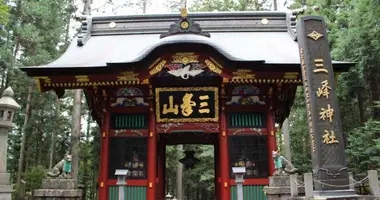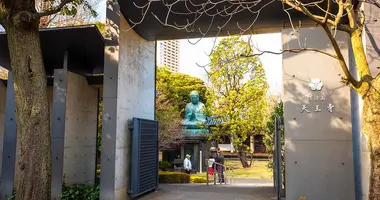Naritasan Shinshoji Temple - An introduction to a millennium-old Buddhist marvel
- Published on : 07/03/2024
- by : Japan Experience
- Youtube
Nestled in the heart of Narita City, just a short distance from Narita International Airport, stands the magnificent Naritasan Shinshoji Temple. This sprawling Buddhist complex, with over a thousand years of history, offers visitors a captivating glimpse into Japan's rich cultural heritage. Founded in 940 AD, Naritasan Shinshoji has evolved into one of the most significant temples in the Kanto region, attracting millions of worshippers and tourists alike each year. As you step through its gates, you'll be transported into a world where ancient traditions blend seamlessly with modern spiritual practices, creating an atmosphere of profound tranquility and wonder.
The rich history and significance of Naritasan Shinshoji Temple
The story of Naritasan Shinshoji Temple is deeply intertwined with Japan's religious and political history. Founded in 940 AD by Kancho Daisojo, a disciple of the revered Buddhist monk Kukai, the temple was established to house a statue of Fudo Myoo (Acala), the Unmovable Wisdom King. This statue, believed to have been carved by Kukai himself, became the temple's principal object of worship and the source of its spiritual power.
The temple's founding is steeped in legend. It's said that the statue of Fudo Myoo was brought to Narita to help quell a rebellion against the imperial court. After the revolt was suppressed, the statue reportedly became too heavy to move, interpreted as a divine sign that it should remain in Narita. This event marked the birth of Naritasan Shinshoji Temple.
Over the centuries, the temple grew in importance and size. It gained particular prominence during the Edo period (1603-1868) when it became a popular pilgrimage site for people from Edo (modern-day Tokyo). The temple's connection to Kabuki theater, especially through the famous actor Ichikawa Danjuro I, further elevated its status and popularity.
Exploring the temple complex: A guide to key structures and attractions
The Naritasan Shinshoji Temple complex is a vast area filled with numerous buildings, each with its own significance and beauty. As you enter through the imposing Somon Gate, built in 2008 for the temple's 1070th anniversary, you'll be greeted by a dramatic rock garden. Proceeding further, you'll encounter the Niomon Gate, an Important Cultural Property dating back to 1831.
The heart of the complex is the Daihondo Main Hall, rebuilt in 1968. This is where the image of Fudo Myoo is enshrined and where the important Goma fire rituals are performed. Nearby stands the Three-Storied Pagoda, a beautiful structure from 1712 that's also designated as an Important Cultural Property.
Other notable buildings include the Shakado Hall, the Shusse-Inari Shrine, and the Komyodo Hall. The Great Peace Pagoda, built in 1984, offers a more modern architectural contrast while still embodying the temple's spiritual essence.
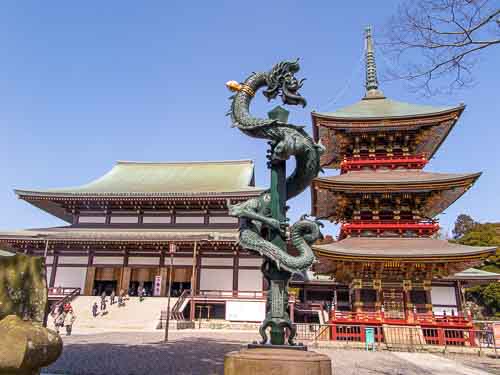
Daihondo Main Hall & Sanju-no-to Pagoda, Naritasan Temple
The spiritual experience: Rituals, prayers, and customs at Naritasan
Naritasan Shinshoji Temple is not just a historical site but a living center of Buddhist practice. The temple is famous for its Goma fire rituals, performed several times daily. During these ceremonies, monks chant sutras and burn wooden sticks representing human desires and afflictions in a symbolic purification ritual.
Visitors are welcome to participate in various spiritual activities. You can write your wishes on wooden tablets(ema) and hang them at designated areas, or participate in sutra copying sessions for a meditative experience. The temple also offers opportunities for guided meditation, though these sessions are primarily conducted in Japanese.
Before entering the main hall, visitors should purify themselves at the chozuya (water purification basin) near the entrance. This involves rinsing your hands and mouth with the provided ladles, a practice that symbolizes cleansing both body and spirit before approaching the sacred space.
Seasonal beauty: Naritasan's changing face throughout the year
The temple grounds are a feast for the eyes in every season. In spring, the Narita-san Park adjacent to the temple bursts into life with cherry blossoms and plum trees in full bloom. Summer brings lush greenery and the vibrant colors of hydrangeas. Autumn transforms the landscape into a tapestry of gold and crimson as the maple leaves change color. Even in winter, the temple exudes a serene beauty, especially when dusted with snow.
Each season brings its own festivals and events. The New Year's celebrations are particularly grand, with millions of visitors flocking to the temple for their first prayers of the year. The Drum Festival in April and the Gion Festival in July are other highlights, offering visitors a chance to experience traditional Japanese culture and festivities.
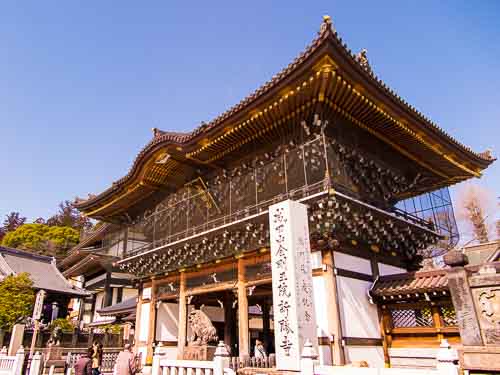
Somon Gate, the entrance to Naritasan Temple.
Cultural significance: Naritasan's connection to Kabuki and Japanese tradition
Naritasan Shinshoji Temple has a unique and longstanding connection to Kabuki theater, particularly through the Ichikawa family of actors. This relationship began in the early 18th century when the famous actor Ichikawa Danjuro I attributed the birth of his son to prayers offered at the temple. Since then, the Ichikawa family has maintained a close relationship with Naritasan, often performing roles inspired by Fudo Myoo and using the stage name "Naritaya".
This connection has not only enriched the temple's cultural significance but also contributed to its popularity. The temple houses numerous votive tablets and artworks donated by Kabuki actors, providing a unique intersection of religious and theatrical art.
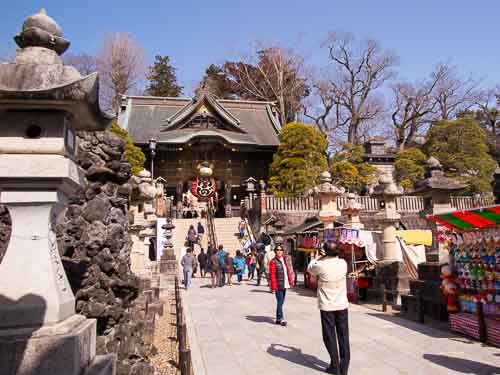
Nioumon Gate, the second gate to Naritasan Temple, Narita
Visitor information: Access, events, and practical tips for your visit
Naritasan Shinshoji Temple is easily accessible from both Narita International Airport and Tokyo. From the airport, it's just a 10-minute train ride to Narita Station, followed by a 10-15 minute walk to the temple. The temple is open daily from early morning until evening, with no admission fee for the main grounds.
Major events at the temple include:
- New Year celebrations (January 1-3)
- Setsubun Festival (February 3)
- Taiko Drum Festival (April)
- Gion Festival (July)
- Annual Burning of Amulets (late December)
For a more in-depth experience, consider joining a guided tour offered by the temple's volunteer guides. These tours, available in English, provide valuable insights into the temple's history and significance.
Beyond the temple: Discovering Narita City and its surroundings
While Naritasan Shinshoji Temple is undoubtedly the star attraction, Narita City offers more to explore. The Omotesando street leading to the temple is lined with traditional shops and restaurants, many specializing in freshwater eel, a local delicacy. Don't miss the opportunity to try some of these culinary specialties.
For those interested in aviation, the nearby Museum of Aeronautical Sciences offers an engaging look at the history of flight. Nature lovers might enjoy a stroll through the Sakura no Yama Park, which offers excellent views of planes taking off and landing at Narita Airport against a backdrop of cherry blossoms in spring.
Whether you're on a layover from Narita International Airport or planning a dedicated visit, Naritasan Shinshoji Temple and its surroundings offer a rich, immersive experience of Japanese culture, spirituality, and history. It's a place where ancient traditions continue to thrive, inviting visitors to step back in time while remaining firmly rooted in the present.
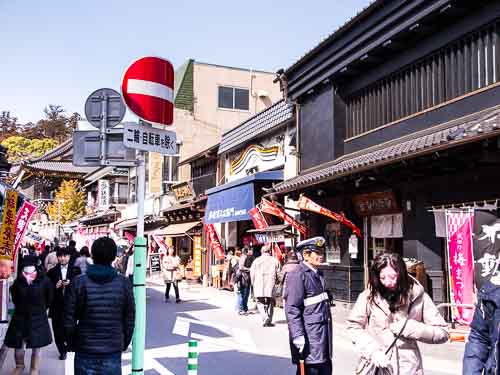
Omotesando Street, leading from Narita Station to Naritasan Temple
















